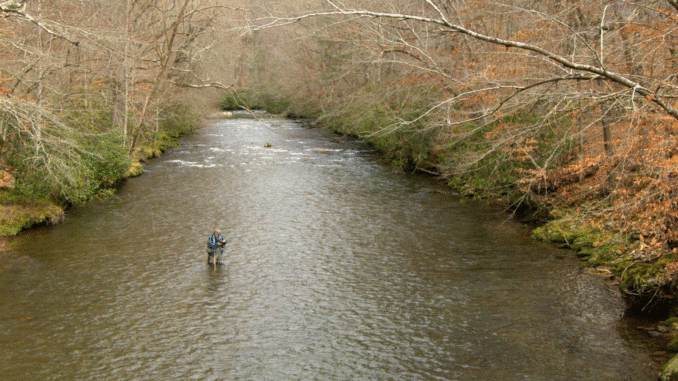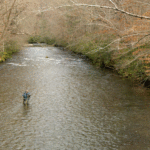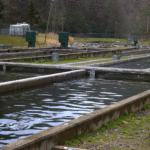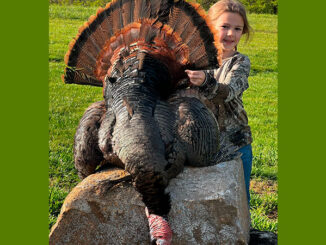
Tribal hatchery rebounding from 2011 flooding
About midnight on July 15, 2011, a flash-flood sent a 10-foot wall of water through the Cherokee Indian Tribal Hatchery, washing away or killing 435,000 trout and leaving raceways buried in silt.
The trout ranged from two to three inches long to six pounds, according to Robert Blankenship, manager of fisheries and wildlife management for the Eastern Band of Cherokee Indians.
It took crews several weeks to clean out raceways and repair the damage. With assistance from the U.S. Fish and Wildlife Service, Blankenship was able to recoup some of the lost trout with surplus fish from federal hatcheries in nearby states, enough to keep the tribe’s popular fishing program in operation through the summer.
“We’re still recovering from the loss,” Blankenship said, “but we should be back to normal by the end of May.”
Cherokee has 30 miles of prime trout waters open to the public in its Enterprise Waters fishing program, including sections of Raven Fork, Bunches Creek, Soco Creek, the Oconaluftee River and three ponds. It is one of the most successful programs of its kind in the Southeast. Raceways can hold and produce 50,000 to 60,000 pounds of trout annually, many of them raised from eggs at the hatchery, others acquired from federal hatcheries.
Blankenship and his crew stock about 400,000 trout per year in Enterprise Waters, 80 percent rainbow and the rest brown and brook trout.
“All of the stocked trout are catchable size,” Blankenship said, describing fish ranging from three-quarters of a pound to one pound. “We also stock 15,000 to 20,000 ‘trophy’ fish that weigh at least two pounds.”
Blankenship also has a 2.2-mile section of Raven Fork in the Big Cove area of the reservation designated as catch-and-release fly-fishing only. Creating the catch-and-release program was one of Blankenship’s primary goals when he became manager of the program in December 2007. It took almost a year to convince tribal leaders to approve the program and get it operational. His next goal is to add another six miles to the catch-and-release program.
“That would give fly-fishers a truer fishing experience,” he said.
Catch-and-release waters contain primarily trophy-size fish that weigh anywhere from two to eight pounds. In addition to rainbow, brook and brown trout, the catch-and-release section also has Donaldson trout and steelhead, which were recently introduced. To make fishing more interesting, palomino (a light orange-colored trout) and golden trout also are added to the mix. The golden trout are bright orange with a red-stripe on their sides.
“People spend hours trying to catch the palominos and golden trout,” Blankenship said.
The catch-and-release program has been as successful as Blankenship hoped, attracting anglers from all over the Southeast, as far away as West Virginia, Florida and Alabama. The majority are 40 and over, but at least 10 percent are in their teens.
Last June, the trophy section was the site of National Fly Fishing Championships. This June, the U.S. Junior National Fly-fishing Championships will be held there. Blankenship plans to make a bid for the World Fly Fishing Championships in the future.
When the program was launched in October 2008, Blankenship said, “We stocked 10,000 pounds of fish, all weighing two pounds or more.”
The trout were fed during their first year. The feeding was discontinued to make the trout more dependent on natural food sources and to make the fishing experience more genuine.
“We stock now only on a need-to basis,” he said.
Cherokee’s fishing program pays part of its expenses in licenses sales alone. A one-day permit to fish Enterprise Waters costs $10; it comes with a generous, 10-fish daily creel limit and no size or bait restrictions. To fish the trophy waters, anglers must pay $25 per day in addition to the daily permit. No other licenses are required for either type of fishing.
Once closed during March, Enterprise Waters are now open year-round. “We still stock in late March just as we did when the waters were closed,” said Blankenship, who predicted that. Enterprise Waters will get between 25,000 and 30,000 trout.
During the winter, streams are stocked once a week. During the high-traffic months of summer and fall, streams are stocked three times a week.
The tribe holds a number of fishing tournaments during the year, beginning with the Cherokee Opening Day Trout Fishing tournament on March 31.
The tribe recently initiated a web-based program allowing fishers to purchase fishing permits on-line. The site can be accessed from www.fishcherokee.com.







Be the first to comment